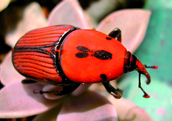 |
This rather handsome looking fellow is enough to send a shiver down the spine of any well brought up palm tree. The rhynchophorus ferrugineos, picudo rojo in Spanish or palm beetle in plain language has had a lot of press over the last couple of years But as it is now chomping its way through our Cómpeta palm trees, I’d like to tell you more about this devastating beetle and the latest ideas on treatment and, perhaps, more importantly – prevention. |
It originates in South East Asia and Polynesia but natural predators there keep it under control – that marvelous way that Mother Nature has. I’m often asked why those self-same natural predators can’t be introduced here to cope with the problem but, of course, this throws out the whole environmental balance and could lead us into even greater problems. It was introduced into Spain in 1994 via a diseased shipment of palms from Egypt to Almuñecar. First seen on the outskirts of Nerja the following year, it soon spread through the provinces of Málaga and Almeria. Over the last thirteen years, it has multiplied at an alarming rate and now threatens most of mainland Spain and her islands.
It’s preferred food source are the Canary Island palms, phoenix canariensis and phoenix dactilyfera, the date palm. Over the years, however, it has been shown that the beetles will also attack other varieties of palms; certainly the Washington palm, washingtonia robusta and w. filifera are susceptible. These four varieties account for the bulk of our palm plantings in this country. But we should not become complacent about their range, as recent research has shown that they will attack almost any type of palm, if their favourites aren’t available. The only one that seems to be immune, at the moment, is the chamaerops humilis, our dwarf native palm.
Spain has an immense heritage of palm trees; the Canary Island palm is endemic to there and it would be a disaster if it were lost. Elche, in Valencia province, has the largest palm plantation in Europe, and has been declared a World Heritage Site, but the beetle arrived there in 2004. In spite of massive efforts, to date, over 1000 palm trees have been lost.
To give you some idea of the scale and spread of the thing, Chipiona, in Cádiz province, initially detected 5 infested trees. Three months later, they were looking at cutting down 600 blighted palms.
The beetle, as can be seen, is a rusty red colour (hence its name) with black markings, some 5 cm long and 1.2 cm wide – so quite unmistakeable. They have a ‘beak’ or pico on the headpiece which, in the males, is hairy. Females lay up to 500 eggs in one batch, generally where the leaves join the trunk or in any fissure or, most devastatingly, in the crown or heart of the palm. They’re creamy-white, rather like a grain of rice and will hatch in about 3 days to ivory-yellow coloured grubs, about 5cm long, with a reddish head. The larval period is around two months and this is when all the damge occurs. They are voracious and will eat metre long tunnels through the trunk and heart of the palm. They then pupate, wrapping themselves in palm fibre, for 3 weeks. Thus 4 generations can be incubated in 1 year – 2000 offspring from one female. They can fly between 4 and 5 kilometres, so it’s easy to see why they’ve spread so quickly.
The first sign you’ll see of infection is an abnormal number of leaves yellowing, a distorting of the leaves and crown and the entire palm will eventually turn straw coloured. Check the base of yellowed leaves; there is usually a reddish deposit left by the larvae. And listen to your tree – you can clearly hear the noise of the larvae chomping away. Eventually the tree will give off a putrid smell as its tissues decompose. Once a palm is infected, the larvae and beetles will live off it until there is no more suitable feeding material. Inside the trunk, it becomes a perfect breeding ground – hot and humid.
The whole issue was initially thought to be a problem for coastal resorts. The colder winter mountain temperatures may limit its activities somewhat but it has certainly not proven to be a barrier. I now know of several infected trees in Cómpeta and it is spreading further and further inland.
Next month, I’ll give you some ideas on prevention and treatment with one of my favourite products – Neem oil. Meanwhile, if you’re concerned about your palms, do come and see me and remember, the Town Hall should be notified of all infected palms.
Lorraine Cavanagh is the author of Mediterranean Garden Plants.
Her plant nursery, Viveros Florena, is on the Algarrobo/Cómpeta Road, 15km up from the coast. Look out for the flowerpot lady. Opening hours Tuesday to Saturday, 10am – 6pm. Also, catch her weekly shows on OCI radio.
Tel: 689928201 florenaspain@hotmail.com






















